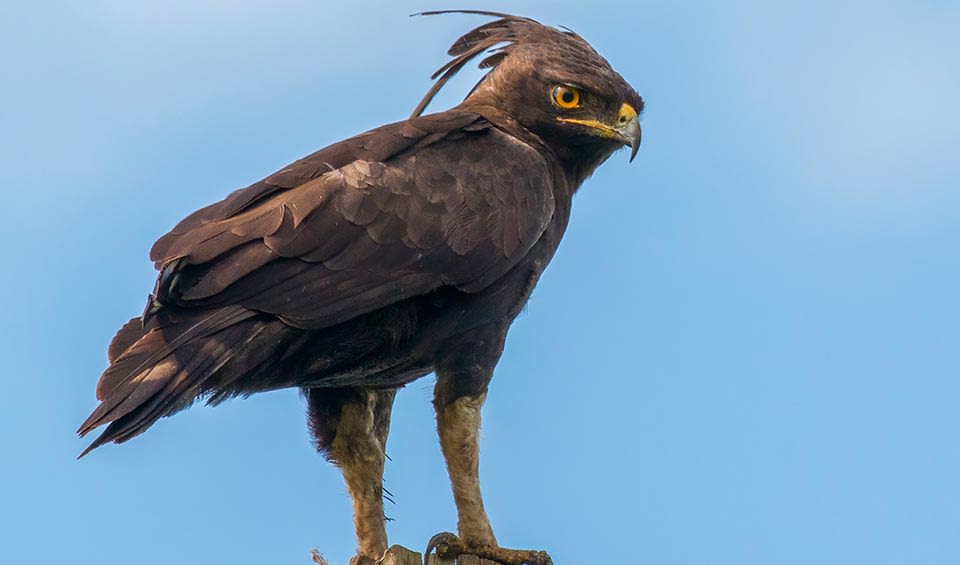A striking and unmistakable bird of prey found throughout sub-Saharan Africa, particularly in areas with a mix of woodlands, savannas, and open farmland. Its name comes from the distinctive, long crest of feathers that often stands upright at the back of its head, giving it a dramatic and almost regal appearance. With its dark plumage, powerful build, and intense stare, the long-crested eagle is a commanding presence perched on a tree branch or gliding above the landscape.
This eagle is mostly blackish-brown, with a bold white patch on the wings visible in flight, and a short, squared-off tail with white bars. Its most eye-catching feature, though, is the tall, floppy crest made up of elongated black feathers, which it raises and lowers depending on its mood or alertness. Its bright yellow eyes add to its fierce, watchful expression.
The long-crested eagle is a perch-and-pounce hunter, often seen sitting quietly on telephone poles, trees, or fence posts, scanning the ground for prey. Its diet is mainly made up of small mammals, especially rodents, which makes it particularly beneficial in agricultural areas where it helps control pest populations. It also eats birds, reptiles, insects, and occasionally carrion. Its hunting method is simple but effective: it watches patiently from a perch and then swoops down swiftly to capture prey in its sharp talons.
Unlike some raptors that prefer remote wilderness, the long-crested eagle is surprisingly tolerant of human presence, and it’s not uncommon to spot one near rural settlements, on farmland, or along roadsides—anywhere with tall perches and open ground. This adaptability has allowed it to maintain healthy populations across much of its range.
Distribution
 Angola
Angola Benin
Benin Botswana
Botswana Burkina Faso
Burkina Faso Burundi
Burundi Cameroon
Cameroon Central Af. Rep.
Central Af. Rep. Chad
Chad Congo-Brazzaville
Congo-Brazzaville Côte D’ivoire
Côte D’ivoire DR Congo (Kinshasa)
DR Congo (Kinshasa) Equatorial Guinea
Equatorial Guinea Eritrea
Eritrea Eswatini
Eswatini Ethiopia
Ethiopia Gabon
Gabon Gambia
Gambia Ghana
Ghana Guinea-Bissau
Guinea-Bissau Guinea
Guinea Kenya
Kenya Liberia
Liberia Malawi
Malawi Mali
Mali Mauritania
Mauritania Mozambique
Mozambique Namibia
Namibia Niger
Niger Nigeria
Nigeria Rwanda
Rwanda Senegal
Senegal Sierra Leone
Sierra Leone Somalia
Somalia South Africa
South Africa South Sudan
South Sudan Sudan
Sudan Tanzania
Tanzania Togo
Togo Uganda
Uganda Zambia
Zambia Zimbabwe
ZimbabweAnything we've missed?
Help us improve this page by suggesting edits. Glory never dies!
Suggest an editGet to know me
Terrestrial / Aquatic
Altricial / Precocial
Polygamous / Monogamous
Dimorphic (size) / Monomorphic
Active: Diurnal / Nocturnal
Social behavior: Solitary / Pack / Herd
Diet: Carnivore / Herbivore / Omnivore / Piscivorous / Insectivore
Migratory: Yes / No
Domesticated: Yes / No
Dangerous: Yes / No




